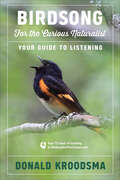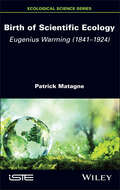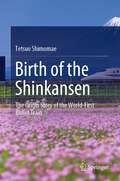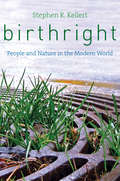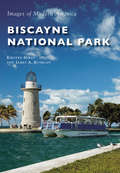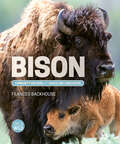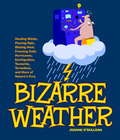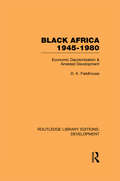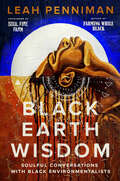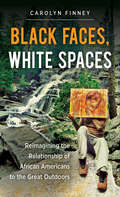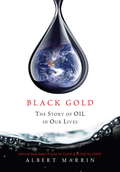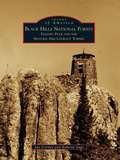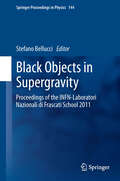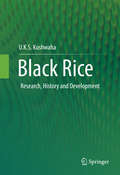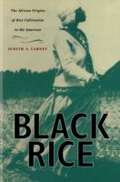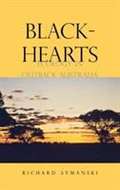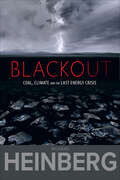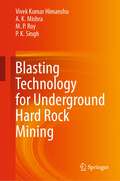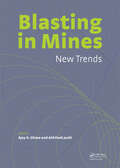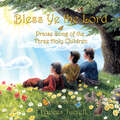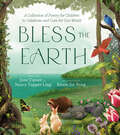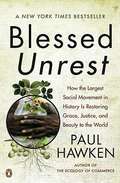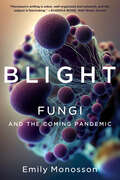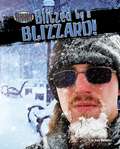- Table View
- List View
Birdsong For The Curious Naturalist: Your Guide to Listening
by Donald KroodsmaBirdsong made easy to understand, lavishly illustrated with color photos, and accompanied by more than 700 online recordings From a leading expert, Birdsong for the Curious Naturalist is a basic, how-to guide that teaches anyone—from beginner to advanced birder—how to listen. In understandable and appealing language, Kroodsma explains why and how birds sing, what various calls mean, and what to listen for from the birds around us. The descriptions are accompanied by color photos of the birds, as well as QR codes that link to an online collection of more than 700 recordings. With these resources, readers are prepared to recognize bird sounds and the birds that make them. Kroodsma encourages readers to find the joy of birdsong and curiosity—to observe, listen intently, be curious, ask questions, and realize that many unanswered questions about birdsong don&’t have to rely on scientists for answers but can be answered by any curious naturalist.
Birth of Scientific Ecology: Eugenius Warming (1841 - 1924)
by Patrick MatagneThis book presents a biography of the Danish botanist Eugen Warming. As the author of a treatise on ecology that brought him international recognition, he was able to inspire the first generation of 20th-century European and American ecologists. His innovative approach to nature and his Arctic and tropical missions heralded the birth of a new science and an ecological awareness. As a professor at several Scandinavian universities during a period of intense debate and controversy over evolutionary theories, Eugen Warming vigorously asserted his convictions. Birth of Scientific Ecology presents the image of a man of knowledge and power, recognized by his contemporaries as a founder of ecology and a player in the ecological project of the Kingdom of Denmark at a time when the empires were clashing.
Birth of the Shinkansen: The Origin Story of the World-First Bullet Train
by Tetsuo ShimomaeThis book discusses the Shinkansen, the world's first high-speed railway, which was born in Japan in 1964 and how it has developed up to the present day. In the 1950s, some European railways were trying to increase the commercial operating speed up to 160 km/h, and it was considered difficult to raise it to 200 km/h. Japanese engineers with excellent engineering ability post World War ll moved from the military to the railways to overcome the technological challenges realizing the high-speed railways using new approaches. The book discusses the technological barriers in speeding up the railway at that time and how these engineers overcame them in non-computer days. In the five decades since the Shinkansen began operating, there have been significant developments enabling high-speed, safe, and frequent train operation with high punctuality while conserving the environment. The book also describes today’s highly evolved Shinkansen. The Shinkansen, which runs 440,000 km a day, has carried 13.3 billion people without a single fatality in 56 years. The book overviews factors that contributed to the Shinkansen’s high safety record. This book is an excellent guide for those interested in the history of the world’s first high-speed railway.
Birthright
by Stephen R. KellertHuman health and well-being are inextricably linked to nature; our connection to the natural world is part of our biological inheritance. In this engaging book, a pioneer in the field of biophilia--the study of human beings' inherent affinity for nature--sets forth the first full account of nature's powerful influence on the quality of our lives. Stephen Kellert asserts that our capacities to think, feel, communicate, create, and find meaning in life all depend upon our relationship to nature. And yet our increasing disconnection and alienation from the natural world reflect how seriously we have undervalued its important role in our lives.Weaving scientific findings together with personal experiences and perspectives, Kellert explores specific human tendencies--including affection, aversion, intellect, control, aesthetics, exploitation, spirituality, and communication--to discover how they are influenced by our relationship with nature. He observes that a beneficial relationship with the natural world is an instinctual inclination, but must be earned. He discusses how we can restore the balance in our relationship by means of changes in childhood development, education, conservation, building design, ethics, and everyday life. Kellert's moving book provides exactly what is needed now: a fresh understanding of how much our essential humanity relies on being a part of the natural world.
Biscayne National Park (Images of Modern America)
by James A. Kushlan Kirsten HinesBiscayne National Park protects the larger portion of south Florida�s Biscayne Bay, a uniquely tropical lagoon harboring crocodiles, manatees, dolphins, and Caribbean fish. Tropical trees cover its islands, while the world�s fourth-longest coral reef sits offshore. Native Americans lived here thousands of years ago; the Spanish held it for 200 years. Hundreds of ships foundered on the reef, fueling a lucrative wrecking industry. In the late 1800s, hardy homesteaders created an agricultural and fishing community. In the 1920s and 1930s, it became a playground for the newly rich and famous. Bracketed by Miami and Key Biscayne to the north and Key Largo to the south, the nearby population eventually grew to over 2.5 million residents and over 14 million annual visitors. To protect these unique natural and historical resources and to assure its enjoyment by future generations, a half century ago, the federal government created Biscayne National Monument, which later became Biscayne National Park.
Bison: Community Builders and Grassland Caretakers (Orca Wild)
by Frances BackhouseBison are North America’s largest land animals. Some 170,000 wood bison once roamed northern regions, while at least 30 million plains bison trekked across the rest of the continent. Almost driven to extinction in the 1800s by decades of slaughter and hunting, this ecological and cultural keystone species supports biodiversity and strengthens the ecosystems around it. Bison: Community Builders and Grassland Caretakers celebrates the traditions and teachings of Indigenous Peoples and looks at how bison lovers of all backgrounds came together to save these iconic animals. Learn about the places where bison are regaining a hoof-hold and meet some of the young people who are welcoming bison back home. The epub edition of this title is fully accessible. Praise for Frances Backhouse: ★"An important book for helping kids see past the sterotypes of terrifying grizzly bears and join the call for conservation."—School Library Journal, starred review for Grizzly Bears "The impressively comprehensive text is chatty and entertaining...This illuminating avian introduction is sure to make an owl out of anyone."—Booklist, review for Owls "An engaging book that will leave readers spouting facts about beavers. Students will have a new appreciation for these innovative builders and their significant impact on the landscape and ecosystems of North America."—School Library Journal, review for Beavers
Bizarre Weather
by Joanne O'SullivanThis is weather beyond your wildest imagination--yet it's all true: showers of worms from the sky, watermelon snow, gory storms, and other freakish and fun phenomena! These stories are anything but ordinary, and they will leave you stunned, horrified, amazed, and sometimes even amused at the incredible things nature can do. Gathered from historic records, present-day news reports and research studies, and spanning the globe from the Sahara to the tundra to the USA, they reveal just how volatile and bizarre weather can be.Find out about supersized hailstones as big as bowling balls; fish raining from the sky; the never-ending lightning that has become a UNESCO National Heritage Site; and fog so thick it killed hundreds of people in a single day. And if that isn't strange enough for you, there are terrible typhoons and tsunamis, tornadoes that have carried people into the air, temperatures that soared over 49 degrees in two minutes, and even cyclones that have raised ships buried for over a century. Scientists can explain how and why some of these things happen--but other events remain a mystery.
Black Africa 1945-1980: Economic Decolonization and Arrested Development (Routledge Library Editions: Development)
by D K FieldhouseIn what ways did economic considerations affect the decision by Britain and France to make their Black African colonies independent? Why were early expectations that independence would lead to rapid and sustained economic development in Africa for the most part disappointed? This title, originally published in 1986, seeks to tackle these two important and strongly debated issues. The main aim and value of the book is to take a broad view of this huge subject, pulling together material on most parts of Black Africa south of the Sahara and north of the Limpopo so that the problem can be seen as a whole. It takes account of a wide range of possible and actual factors which have influenced African economic development, weaving them into a single analysis, including the colonial inheritance, the impact of the fluctuating international economy, policies adopted by African governments and indigenous factors such as climate, drought and human resources. The book is written to be understood without difficulty by non-specialists and is intended to act as an introduction to its subject for university students.
Black Bear: North America's Bear
by Stephen R. SwinburneThree species of bear inhabit North America: the grizzly, the polar bear, and the black bear. But the American black bear is truly North America's bear, found only in North America. Black bears range from Canada to Mexico, from New England to California. There may be as many as 750,000 black bears roaming the forests and mountains of the continent. With its large population, and with more people moving into black bear territory, it's important that we understand this magnificent animal. <P><P> Stephen R. Swinburne takes us to where black bears live. He joins biologists in search of bears in the Pennsylvania woods, where a mother bear is examined and her cubs tagged. He visits a "school teacher" for orphaned cubs who teaches them how to survive in the wild. Along the way, he offers his personal observations together with fascinating facts about black bears and their world. (Did you know that in the autumn, black bears consume as much as twenty thousand calories a day? That's equivalent to forty-two hamburgers!) <P><P> With stunning full-color and archival photographs, this lively book shows how North America's bear behaves and survives.
Black Earth Wisdom: Soulful Conversations with Black Environmentalists
by Leah PennimanA soulful collection of illuminating essays and interviews that explore Black people’s spiritual and scientific connection to the land, waters, and climate, curated by the acclaimed author of Farming While BlackAuthor of Farming While Black and co-founder of Soul Fire Farm, Leah Penniman reminds us that ecological humility is an intrinsic part of Black cultural heritage. While racial capitalism has attempted to sever our connection to the sacred earth for 400 years, Black people have long seen the land and water as family and understood the intrinsic value of nature.This thought-provoking anthology brings together today’s most respected and influential Black environmentalist voices —leaders who have cultivated the skill of listening to the Earth —to share the lessons they have learned. These varied and distinguished experts include Pulitzer Prize and National Book Award-winning author Alice Walker; the first Queen Mother and official spokesperson for the Gullah/Geechee Nation, Queen Quet; marine biologist, policy expert, and founder and president of Ocean Collectiv, Dr. Ayana Elizabeth Johnson; and the Executive Director of the North Carolina Association of Black Lawyers, Land Loss Prevention Project, Savi Horne. In Black Earth Wisdom, they address the essential connection between nature and our survival and how runaway consumption and corporate insatiability are harming the earth and every facet of American society, engendering racial violence, food apartheid, and climate injustice.Those whose skin is the color of soil are reviving their ancestral and ancient practice of listening to the earth for guidance. Penniman makes clear that the fight for racial and environmental justice demands that people put our planet first and defer to nature as our ultimate teacher.Contributors include:Alice Walker • adrienne maree brown • Dr. Ross Gay • Dr. Ayana Elizabeth Johnson • Rue Mapp • Dr. Carolyn Finney • Audrey Peterman • Awise Agbaye Wande Abimbola • Ibrahim Abdul-Matin • Kendra Pierre-Louis • Latria Graham • Dr. Lauret Savoy •Ira Wallace • Savi Horne • Dr. Claudia Ford • Dr. J. Drew Lanham • Dr. Leni Sorensen • Queen Quet • Toshi Reagon • Yeye Luisah Teish • Yonnette Fleming • Naima Penniman • Angelou Ezeilo • James Edward Mills • Teresa Baker • Pandora Thomas • Toi Scott • Aleya Fraser • Chris Bolden-Newsome • Dr. Joshua Bennett • B. Anderson • Chris Hill • Greg Watson • T. Morgan Dixon • Dr. Dorceta Taylor • Colette Pichon Battle • Dillon Bernard • Sharon Lavigne • Steve Curwood • and Babalawo Enroue Halfkenny
Black Faces, White Spaces
by Carolyn FinneyWhy are African Americans so underrepresented when it comes to interest in nature, outdoor recreation, and environmentalism? In this thought-provoking study, Carolyn Finney looks beyond the discourse of the environmental justice movement to examine how the natural environment has been understood, commodified, and represented by both white and black Americans. Bridging the fields of environmental history, cultural studies, critical race studies, and geography, Finney argues that the legacies of slavery, Jim Crow, and racial violence have shaped cultural understandings of the "great outdoors" and determined who should and can have access to natural spaces. Drawing on a variety of sources from film, literature, and popular culture, and analyzing different historical moments, including the establishment of the Wilderness Act in 1964 and the aftermath of Hurricane Katrina, Finney reveals the perceived and real ways in which nature and the environment are racialized in America. Looking toward the future, she also highlights the work of African Americans who are opening doors to greater participation in environmental and conservation concerns.
Black Gold: The Story of Oil in Our Lives
by Albert MarrinOil is not pretty, but it is a resource that drives the modern world. It has made fortunes for the lucky few and provided jobs for millions of ordinary folks. <P><P>Thick and slippery, crude oil has an evil smell. Yet without it, life as we live it today would be impossible. Oil fuels our engines, heats our homes, and powers the machines that make the everyday things we take for granted, from shopping bags to computers to medical equipment. Nations throughout the last century have gone to war over it. Indeed, oil influences every aspect of modern life. It helps shape the history, society, politics, and economy of every nation on earth. <P><P>This riveting new book explores what oil is and the role this precious resource has played in America and the world.
Black Hills National Forest: Harney Peak and the Historic Fire Lookout Towers
by Jan Cerney Roberta SagoOnce vital to fire prevention and detection, most of the Black Hills National Forest historic lookout towers now serve primarily as hiking destinations. The first crude lookout structures were built at Custer Peak and Harney Peak in 1911. Since that time, more than 20 towers have been constructed in the area. The first lookout towers were built of wood, most replaced by steel or stone. The Civilian Conservation Corps was instrumental in constructing fire towers during the 1930s and 1940s. One of the most famous and architecturally and aesthetically valued towers is the Harney Peak Fire Lookout--situated on the highest point east of the Rocky Mountains. Harney Peak is among a number of Black Hills towers listed on the National Historic Lookout Register. Over 200 vintage images tell the story of not only the historic fire towers but those who manned them. Perched atop high peaks in remote locations, fire lookout personnel spent countless hours scanning the forest, pinpointing dangers, often experiencing the powerful wrath of lightning strong enough to jolt them off their lightning stools.
Black Objects in Supergravity: Proceedings of the INFN-Laboratori Nazionali di Frascati School 2011 (Springer Proceedings in Physics #144)
by Stefano BellucciThis is the sixth volume in a series of books on the general topics of supersymmetry, supergravity, black holes and the attractor mechanism. The present volume is based upon lectures held in May 2011 at the INFN-Laboratori Nazionali di Frascati School on Black Objects in Supergravity (BOSS2011), directed by Stefano Bellucci, with the participation of prestigious lecturers, including G. Lopes Cardoso, W. Chemissany, T. Ortin, J. Perz, O. Vaughan, D. Turton, L. Lusanna and S. Ferrara. All lectures were at a pedagogical, introductory level, a feature which is reflected in the specific "flavor" of this volume, which also benefited greatly from extensive discussions and related reworking of the various contributions.
Black Rice: Research, History and Development
by U. K. S. KushwahaThe main purpose of this book is to introduce black rice to a wider circle of people. Although there has been research on different aspects of black rice, the information is scattered and not easily accessible to laypersons. The book intends to cover all aspects of black rice; from research, history, to its development. As such, the book will be suitable for both rice researchers and non-professionals who want to know more about this unique rice crop.
Black Rice: The African Origins Of Rice Cultivation In The Americas
by Judith A. CarneyFew Americans identify slavery with the cultivation of rice, yet rice was a major plantation crop during the first three centuries of settlement in the Americas. Rice accompanied African slaves across the Middle Passage throughout the New World to Brazil, the Caribbean, and the southern United States. By the middle of the eighteenth century, rice plantations in South Carolina and the black slaves who worked them had created one of the most profitable economies in the world. Black Rice tells the story of the true provenance of rice in the Americas. It establishes, through agricultural and historical evidence, the vital significance of rice in West African society for a millennium before Europeans arrived and the slave trade began. The standard belief that Europeans introduced rice to West Africa and then brought the knowledge of its cultivation to the Americas is a fundamental fallacy, one which succeeds in effacing the origins of the crop and the role of Africans and African-American slaves in transferring the seed, the cultivation skills, and the cultural practices necessary for establishing it in the New World. In this vivid interpretation of rice and slaves in the Atlantic world, Judith Carney reveals how racism has shaped our historical memory and neglected this critical African contribution to the making of the Americas.
Blackhearts: Ecology in Outback Australia
by Richard SymanskiThis fascinating book is a firsthand account of the adventures of an ornithological field team studying long-tailed finches in outback Australia. In 1991, Nancy Burley, a noted behavioral ecologist, and her husband, Richard Symanski, went to Australia with their one-year-old son and four American students hired as field assistants and babysitter. The social relationships and problems that developed among these individuals in confined and exotic settings and the scientific discoveries that did -- and did not -- take place form the heart of the book. Symanski begins by telling how he and his wife set up this elaborate field expedition -- including the hiring of what seemed to be qualified, compatible, and knowledgeable field assistants. He then describes the harsh realities of their circumstances in Australia: primitive living conditions on an outback cattle station; field sites and subjects for study that were not as expected; and students who were not prepared for the rigors of field life and who became unenthusiastic about the work for which they had been hired. And he tells how he and his wife strove to overcome all the different challenges with which they were confronted. The book provides insight into the demands of professor-student-based fieldwork, particularly when generational conflicts, differing expectations, and culture shock complicate the "business" of doing science.
Blackout: Coal, Climate and the Last Energy Crisis
by Richard HeinbergCoal fuels about 50 percent of US electricity production and provides a quarter of the country's total energy. China and India's ferocious economic growth is based almost entirely on coal-generated electricity.Coal currently looks like a solution to many of our fast-growing energy problems. However, while coal advocates are urging full steam ahead, increasing reliance on the dirtiest of all fossil fuels has crucial implications for the global climate, energy policy, the world economy, and geopolitics.Drawbacks to a coal-based energy strategy include:Scarcity – new studies suggest that the peak of world coal production may actually be less than two decades away.Cost – the quality of produced coal is declining, while the expense of transport is rising, leading to spiraling costs and increasing shortages.Climate impacts - our ability to deal with the historic challenge of climate change will hinge on reducing our coal consumption in future years.Blackout goes to the heart of the tough energy questions that will dominate every sphere of public policy throughout the first half of this century, and is a must-read for planners, educators, and anyone concerned about energy consumption, peak oil and climate change.
Blasting Technology for Underground Hard Rock Mining
by Vivek Kumar Himanshu A. K. Mishra M. P. Roy P. K. SinghThis book presents the principles and practices of rock blasting for underground hard rock mining. It covers a theoretical background of the rock blasting technology and comprehensive case studies on different stages of rock blasting for underground metalliferous mining. It includes the discussions on burn-cut face blasting pattern, slot raise excavation methodology, and ring blasting methods. It further discusses different practical challenges associated with underground blasting, viz. ore dilution, ground vibration, wall instability, etc., and their possible solutions. The book also covers the recent advancements in methodologies to predict blasting outcomes and instrumentations for monitoring rock blasting operations. The book is a useful reference for rock blasting practitioners, mining engineers, professionals, and researchers. It is also a valuable reference for undergraduate and postgraduate students.
Blasting in Mining - New Trends
by Ajoy K. Ghose Akhilesh JoshiBlasting practices in mines have undergone many changes in the recent past and continue to be honed and reconfigured to meet the demands of today�s mining needs. This volume compiles papers of the workshop Blasting in Mines � New Trends, hosted by the Fragblast 10 Symposium . The 17 papers provide a mix which highlight the evolving trends in blasti
Bless Ye the Lord: Praise Song of the Three Holy Children
by Frances TyrrellHere is the song of three children who are calling upon all of creation—the angels, heavenly bodies, seasons, waters, hills, plants, animals, birds, and men—to exalt and glorify the Lord. &“Bless ye the Lord; praise Him, and magnify Him forever . . .&” Their lyrical song of praise and gratitude—reminiscent of St. Francis of Assisi's &“Canticle of the Sun&”—appears in the Book of Daniel in the oldest versions of the Christian Bible, and in the Apocrypha of later editions. Their Hebrew names were Ananias, Azarias, and Misael, and they were also known by their Babylonian names of Shadrach, Meshach, and Abednego. Radiant illustrations by artist Frances Tyrrell show scenes of their idyllic childhood days, when the three children were free to explore the hills, fields, and streams of their homeland.
Bless the Earth: A Collection of Poetry for Children to Celebrate and Care for Our World
by June Cotner Nancy Tupper LingA beautifully illustrated collection of poems and prayers to help children develop an appreciation for the natural worldBless the Earth, our faithful friend,her mountain range and river bend,her forest green and canopy,the hidden world of bended trees. Bless the Earth shows the miracle of our planet Earth through beautiful imagery and delightful poetry, calling all people, young and old, to care for our wonderful world. This sweet and welcoming anthology for children ages 3-7 knits together our common humanity and the natural world in an engaging way that is simple for young readers to understand.Bless the Earth contains approximately sixty selections of original as well as classic poems, divided into five chapters each:Dreams for My WorldEarth and SkyAll Creatures, Big and SmallSeasonsCaring for Our World Bless the Earth calls us again and again to understand how important it is to care for our world, respect our neighbors—humans, plants, and animals alike—and reimagine a world that is healthy and whole.
Blessed Unrest
by Paul HawkenOrganizations working to restore the environment and foster social justice collectively comprise the largest movement on earth. This movement with no name, leader, or location is a creative expression of people's needs worldwide.
Blight: Fungi and the Coming Pandemic
by Emily MonossonWinner of the 2024 Phi Beta Kappa Award for Science A New York Times Editors' Choice A Science News Favorite Book of 2023 "Fungi sicken us and fungi sustain us. In either case, we ignore them at our peril." —Elizabeth Kolbert, New York Review of Books A prescient warning about the mysterious and deadly world of fungi—and how to avert further loss across species, including our own. Fungi are everywhere. Most are harmless; some are helpful. A few are killers. Collectively, infectious fungi are the most devastating agents of disease on earth, and a fungus that can persist in the environment without its host is here to stay. In Blight, Emily Monosson documents how trade, travel, and a changing climate are making us all more vulnerable to invasion. Populations of bats, frogs, and salamanders face extinction. In the Northwest, America’s beloved national parks are covered with the spindly corpses of whitebark pines. Food crops are under siege, threatening our coffee, bananas, and wheat—and, more broadly, our global food security. Candida auris, drug-resistant and resilient, infects hospital patients and those with weakened immune systems. Coccidioides, which lives in drier dusty regions, may cause infection in apparently healthy people. The horrors go on. Yet prevention is not impossible. Tracing the history of fungal spread and the most recent discoveries in the field, Monosson meets scientists who are working tirelessly to protect species under threat, and whose innovative approaches to fungal invasion have the potential to save human lives. Delving into case studies at once fascinating, sobering, and hopeful, Blight serves as a wake-up call, a reminder of the delicate interconnectedness of the natural world, and a lesson in seeing life on our planet with renewed humility and awe.
Blitzed by a Blizzard! (Disaster Survivors)
by Joyce MarkovicsOn December 29, 2007, a fierce blizzard hit Olympia National Park in Washington State. Cross-country skier Randy Kraxberger, traveling alone, was caught by himself in the severe winter storm. Park rangers knew they had to save the lost skier. Could their daring rescue effort succeed through blinding snow, high winds, freezing temperatures, and the threat of avalanches? Safety tips show young readers how to stay out of harms way during a blizzard.
